IN THE COMPANY OF "SMALL CUPS"
Cups have been around probably since mankind realized
anything was
superior to
"cupping"
hands for precious liquids.
Trial and error with heat-hardened clay and early metal-working finally perfected...
"the drinking cup"!
Among the most charming and collectible are
the "small silver cups" of the 17th and 18th centuries.
Here are a few English examples,
accompanied by historic sentiments on their behalf :
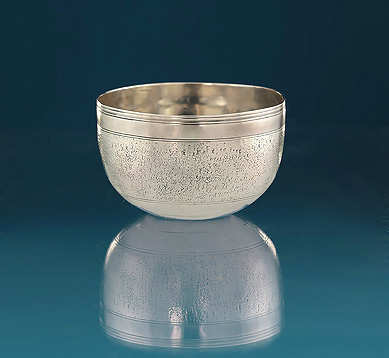
James II / William & Mary Small Silver 'Tumbler Cup'
RS a mullet below, Roger Strickland, London, c1690
"There's many a slip between the cup and the lip."
(Aristotle)
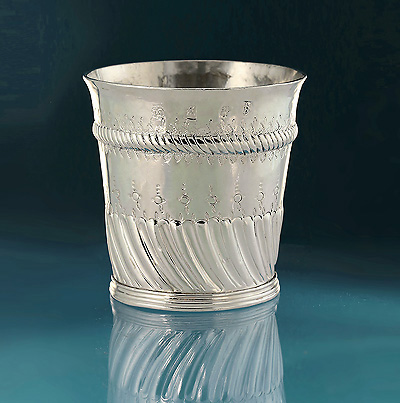
Queen Anne Britannia Silver 'Beaker'
William Gibson, London, 1702
"A full cup of wine at the right time is worth more than all the kingdoms... "
(Gustav
Mahler)
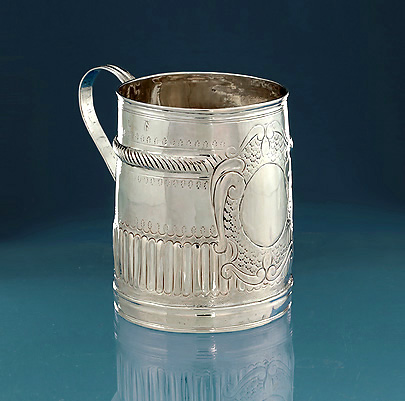
Rare Queen Anne Britannia Silver Child's 'Mug'
Matthew Cooper, London, 1705-6
"Bring
me the sunset in a cup."
(Emily Dickinson)
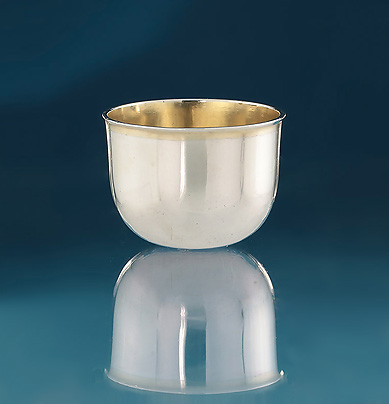
George I Silver 'Tumbler Cup'
James Goodwin, London, 1723
"This cup which nature puts to our lips, has a wonderful virtue,
surpassing that of any other draught.
It opens the senses, adds power, fills us with exalted dreams,
which we call 'hope, love, ambition, science',
especially it creates a craving for LARGER draughts of itself."
(Ralph Waldo Emerson)
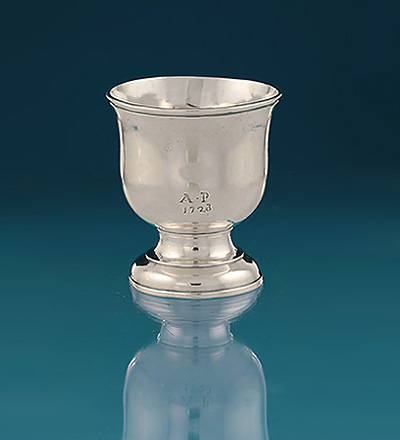
Scarce George I Silver 'Tot Cup'
1724, Scratch-Initialled 'AP 1723'
"And life's enchanted cup but sparkles near the brim."
(Lord Byron)
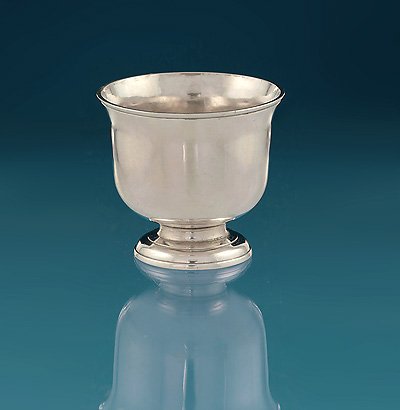
Scarce Early George II Silver "Tot Cup"
Thomas Parr II, London, 1730
"Reach out your hand if your cup be empty,
If your cup is full, may it be again."
(From "Ripple", Robert Hunter & Jerry Garcia)
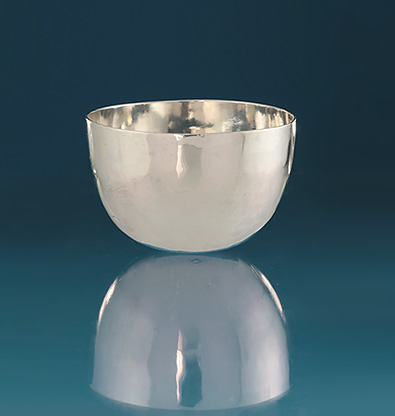
Early George II Silver 'Tumbler Cup'
William Allen I (likely), London, 1731
"...Or leave a kiss but in the cup
And I'll not look for wine."
(Ben Jonson)
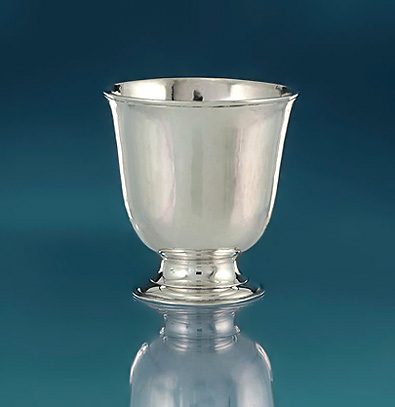
Scarce Early George II Silver 'Tot Cup'
William Paradise, London, 1732
Owner's initials Initials Verso : C over W.M
"Take one cup of love, two cups of loyalty, three cups of forgiveness,
four quarts of faith and one barrel of laughter."
(Zig Ziglar)
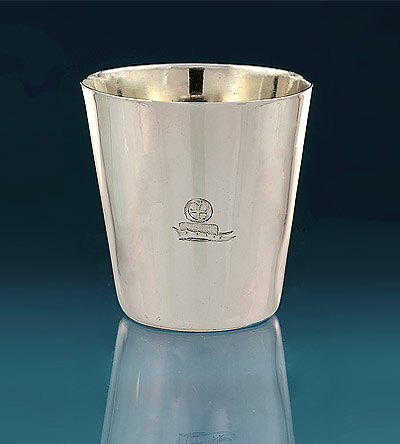
George III Silver 'Beaker'
Aaron Lestourgen, London 1774
Crested for the Family of Kirkby of Northwest England
"We'll tak a cup o' kindness yet,
For auld lang syne."
(Robert Burns)
(Each cup above is linked to a
'detail page')
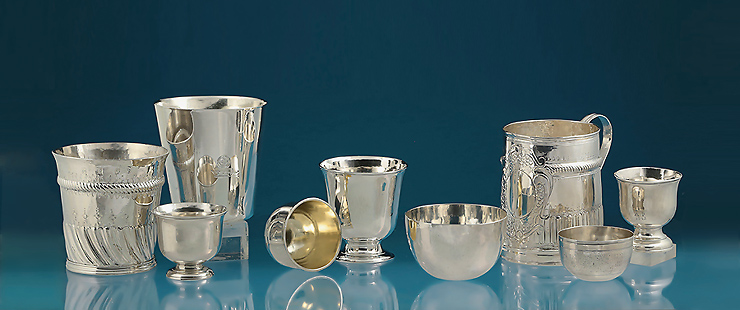
"CUP TRIVIA"
Early Neolithic drinking vessels were made from "coiled pottery"
(the clay coiled, stacked, dried, then fired)
have been found worldwide.
The vessels were a great improvement over
hewn wood and animal skulls,
yet still quite thick and difficult for drinking.
New York's Metropolitan Museum houses this small Middle
Eastern pottery cup,
dating close to 6000 BC :.
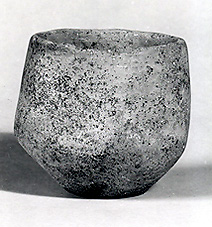
The potter's wheel emerged about 5000 BC, most likely in Mesopotamia...
although China and Europe also claim origin.
An interesting coincidence!
The wheel enabled speed and refinement to the making of vessels -
and cups.
The sophisticated handled cup below originated in the middle to lower reaches
of China's Yellow River, about 2500 BC :
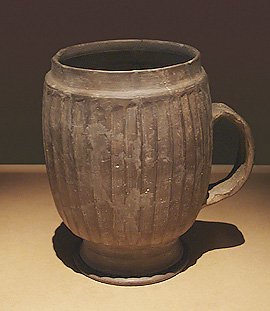
A Henan Longshan Culture heated clay "handled cup", China, c2500 BC,
turned on a wheel, and possibly originally with a cover.
(Image, Creative Commons)
Earlier Chinese potters
had also added
"side loops"
to their vessels.
As they were ancestor
worshipers, their loops were in imitation of
"human ears"
-- in hopes that the ancestors would recognize the vessels as "familiar",
come to live within the vessels, and bless the contents.
These "loops" in time became "handles".
"BEAKERS, & THE BEAKER FOLK"
Cylindrical
'beakers' date back at least 6000 years, being abundant during Biblical times.
About 2800 BC, people
known as the
"Bell Beaker Culture",
or
"Beaker Folk",
slowly migrated from the Eurasian Steppes throughout Western Europe.
They brought with them their advanced metal-working and pottery skills, including
an open flat bottomed cup called the "beaker".
Their search for copper and gold expanded their migration westward -
and about 2500 BC, into England and Ireland.
In addition to their "bell beaker", the "Beaker Folk" brought into Britain
their entire culture... including their customs, beliefs, and
the "fair complexion and eyes" still dominant in Great Britain today.
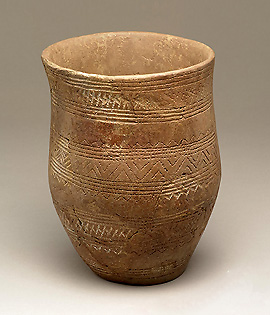
Polished Red Buff Pottery Beaker Cup, c1800-1600 BC,
Found, Sewell, Bedfordshire, England
British Museum (Image, Creative Commons)
By about
1700 BC, the
Beaker
culture
began to decline in Britain.
However, a
distinct metalwork
"beaker cup"
remained,
influenced by the Beaker Folk shapes of the Rhine area and of Ireland -
whose construction has changed little since that time :
made in three parts,
the sides tapering and hammered into the round,
seamed vertically.
Small silver beakers were commonly used in England from c1560-1685.
Very few from the the 1500s and early 1600s remain.
Further, 18th century glass production overshadowed the British silver beaker,
and from c1700 forward, they were made in much smaller numbers.
"TUMBLER CUPS"
One of the earliest records of tumbler cups is that of Samuel Pepys, on October 24, 1664.
He cites an odd alternate name -
"cocking cups".
At that time, in the north-west of England,
these small cups were sometimes given as prizes given in cockfighting contests.
The earliest silver known tumbler cups still in existence date to 1671, at All Souls Oxford.
These early small, plain drinking cups were first popular at 17th century colleges,
(as Oxford) and intended to be emptied in a single draught.
The cups were hammered up from a single sheet of thick silver,
with a heavier rounded base and thinner sides.
This construction allowed the cup to right itself when knocked –
thus the name
"tumbler",
from the Germanic word for
"acrobat".
This righting
action
was also useful to travelers of the day.
"TOT CUPS"
"Tot cups" are small cups, usually footed as a beaker,
and dram ("mouthful") size - about 2 inches.
From about 1670 to 1760, these cups were often handed to riders before or after a hunt,
or as a
"friendship or parting cup"
to riders at the beginning or end of a journey.
Tot cups are the predecessor of the George III "stirrup cups", and likewise
meant to be drunk without putting the vessel down.
However, most have a small foot, and sometimes a handle.
Early silver tot cups of any form are scarce ... if not rare.
Inventory Photography :
Millicent F. Creech
|